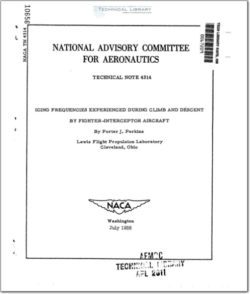NACA-TN-4314

- Version
- 148 Downloads
- 1.12 MB File Size
- 1 File Count
- December 4, 2015 Create Date
- December 4, 2015 Last Updated
National Advisory Committee for Aeronautics, Technical Notes - Icing Frequencies Experienced During Climb and Descent by Fighter Intercept Aircraft

Data and analyses are presented on the relative frequencies of
occurrence and severity of icing cloud layers encountered by Jet aircraft
in the climb and descent phases of flights to high altitudes. Fighter-
interceptor aircraft operated by the Air Defense Command (USAF) at bases
in the Duluth and Seattle areas collected the data with icing meters
installed for a 1—year period. The project was part of an extensive
program conducted by the NADA to collect icing cloud data for evaluating
the icing problem relevant to routine operations.
The average frequency of occurrence of icing was found to be about
5 percent of the number of climbs and descents during 1 year of opera-
tions. The icing encounters were predominantly in the low and middle
cloud layers, decreasing above 15,000 feet to practically none above
25,000 feet.
The greatest thickness of ice that would accumulate on any aircraft
component (as indicated by the accretion on a small object) was measured
with the icing meters. The ice thicknesses on a small sensing probe
averaged less than 1/52 inch and did not exceed 1/2 inch. Such accumula-
tions are relatively small when compared with those that can form during
horizontal flight in icing clouds. The light accretions resulted from
relatively steep angles of flight through generally thin cloud layers.
Because of the limited statistical reliability of the results, an
analysis was made using previous statistics on icing clouds below an
altitude of 20,000 feet to determine the general icing severity prob-
abilities. The calculations were made using adiabatic lifting as a basis
to establish the liquid-water content. Probabilities of over-all ice
accretions on a small object as a function of airspeed and rate of climb
were computed from the derived water contents. These results were then
combined with the probability of occurrence of icing in order to give '
the icing severity that can be expected for routine aircraft operations.
| File | Action |
|---|---|
| naca-tn-4314.pdf | Download |
Comment On This Post